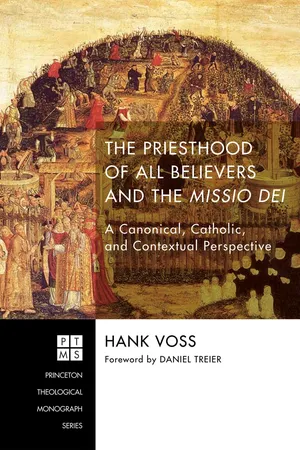
The Priesthood of All Believers and the Missio Dei
A Canonical, Catholic, and Contextual Perspective
- 344 pages
- English
- ePUB (mobile friendly)
- Available on iOS & Android
The Priesthood of All Believers and the Missio Dei
A Canonical, Catholic, and Contextual Perspective
About this book
The priesthood of all believers is a pillar undergirding Protestant ecclesiology. Yet the doctrine has often been used to serve diverse agendas. This book examines the doctrine's canonical, catholic, and contextual dimensions. It first identifies the priesthood of all believers as a canonical doctrine based upon the royal priesthood of Christ and closely related to the believer's eschatological temple-service and offering of spiritual sacrifices (chapters 1-3). It secondly describes its catholic development by examining three paradigmatic shifts, shifts especially associated with Christendom (chapters 4-6) and a suppression of the doctrine's missional component. Finally, the book argues that a Christian doctrine of the priesthood of all believers should be developed with a Christocentric-Trinitarian understanding of the missio Dei. This suggests there are especially appropriate ways for the royal priesthood to relate to the Father, to the Son, and to the Holy Spirit. A canonically and catholically informed priesthood of all believers leads contextually to particular ecclesial practices. These seven practices are 1) Baptism as public ordination to the royal priesthood; 2) Prayer; 3) Lectio Divina; 4) Ministry; 5) Church Discipline; 6) Proclamation; and 7) the Lord's Supper as the renewal of the royal priesthood.
Frequently asked questions
- Essential is ideal for learners and professionals who enjoy exploring a wide range of subjects. Access the Essential Library with 800,000+ trusted titles and best-sellers across business, personal growth, and the humanities. Includes unlimited reading time and Standard Read Aloud voice.
- Complete: Perfect for advanced learners and researchers needing full, unrestricted access. Unlock 1.4M+ books across hundreds of subjects, including academic and specialized titles. The Complete Plan also includes advanced features like Premium Read Aloud and Research Assistant.
Please note we cannot support devices running on iOS 13 and Android 7 or earlier. Learn more about using the app.
Information
The Royal Priesthood in Scripture’s Script
Royal Priests: Actors in the New Testament’s Story
Table of contents
- Title Page
- Foreword
- Preface
- Acknowledgments
- Abbreviations
- Introduction
- Part I: The Royal Priesthood in Scripture’s Script
- Part II: From Actors to Audience and Back Again: The Royal Priesthood’s Story across the Centuries
- Part III: The Royal Priesthood in Today’s World
- Conclusion
- Appendix: Significant Figures and Events for the Royal Priesthood: First through Twenty-first Ce
- Bibliography